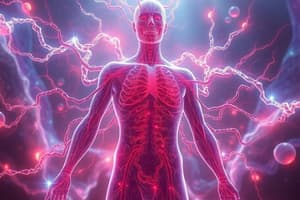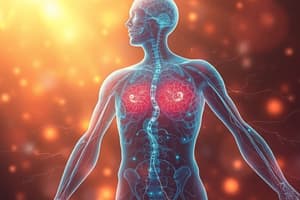Podcast
Questions and Answers
Predict the consequence of complete removal of the spleen on an individual's ability to combat infections and maintain overall blood health.
Predict the consequence of complete removal of the spleen on an individual's ability to combat infections and maintain overall blood health.
- No significant change in immune function or blood health, as the spleen's functions are entirely compensated by other lymphoid organs.
- Increased susceptibility to encapsulated bacteria and impaired removal of damaged blood cells, potentially leading to compromised immune responses. (correct)
- Enhanced immune response due to the absence of splenic regulation, leading to heightened defense against all types of pathogens.
- Decreased risk of autoimmune diseases due to the elimination of a major site of lymphocyte activation.
How would the absence of mini-valves in lymphatic capillaries impact fluid balance and tissue health?
How would the absence of mini-valves in lymphatic capillaries impact fluid balance and tissue health?
- Edema would develop because fluid entry into lymphatic capillaries would be prevented.
- Nutrient delivery to tissues would increase because fluid would be forced into tissues due to increased interstitial pressure.
- Fluid would accumulate in tissues because leaked proteins could not be returned to the bloodstream. (correct)
- The lymphatic capillaries would collapse, preventing any fluid flow.
What is the most likely outcome if the thoracic duct were to become blocked or damaged?
What is the most likely outcome if the thoracic duct were to become blocked or damaged?
- The right side of the body would experience significant edema, while the left side would remain unaffected.
- Only lymph from the lower extremities and abdomen would be affected, resulting in localized edema in those regions.
- Collateral lymphatic vessels would immediately compensate, preventing any noticeable symptoms.
- Lymph from the entire body would be unable to return to the bloodstream, leading to widespread edema and immune dysfunction. (correct)
What consequence would arise if the thymus gland failed to develop properly during embryonic development?
What consequence would arise if the thymus gland failed to develop properly during embryonic development?
Predict the effect of a genetic defect that impairs the ability of lymphocytes to migrate into lymphoid tissues.
Predict the effect of a genetic defect that impairs the ability of lymphocytes to migrate into lymphoid tissues.
Which of the following scenarios would most severely compromise the ability of lymph nodes to effectively filter lymph?
Which of the following scenarios would most severely compromise the ability of lymph nodes to effectively filter lymph?
What is the likely outcome if the lymphatic system were unable to transport dietary fats from the small intestine?
What is the likely outcome if the lymphatic system were unable to transport dietary fats from the small intestine?
A patient presents with lymphedema in the right lower limb following a surgical procedure. What lymphatic structure was most likely damaged during the procedure?
A patient presents with lymphedema in the right lower limb following a surgical procedure. What lymphatic structure was most likely damaged during the procedure?
What would happen if the smooth muscle in lymphatic vessel walls were paralyzed?
What would happen if the smooth muscle in lymphatic vessel walls were paralyzed?
If a pathogen could specifically disable the ability of antibodies to mark antigens for destruction, what immune process would be most directly compromised?
If a pathogen could specifically disable the ability of antibodies to mark antigens for destruction, what immune process would be most directly compromised?
Which cells are primarily responsible for the immune response in the lymphatic system?
Which cells are primarily responsible for the immune response in the lymphatic system?
Which part of the lymphatic system is primarily responsible for filtering lymph and producing lymphocytes?
Which part of the lymphatic system is primarily responsible for filtering lymph and producing lymphocytes?
Which of the following is a primary function of the lymphatic system?
Which of the following is a primary function of the lymphatic system?
Which of the following best describes the primary function of the lymphatic system?
Which of the following best describes the primary function of the lymphatic system?
What is the main function of the lymphatic system?
What is the main function of the lymphatic system?
Which of the following components are part of the lymphatic system?
Which of the following components are part of the lymphatic system?
Which of the following is a primary function of the lymphatic system?
Which of the following is a primary function of the lymphatic system?
Flashcards
Lymph Nodes
Lymph Nodes
Small, bean-shaped organs that cluster along lymphatic vessels, filtering lymph and activating the immune system.
Thymus
Thymus
An immune organ that functions strictly in T lymphocyte maturation and does not directly fight antigens; consists of epithelial tissue.
Lymph Transport Mechanisms
Lymph Transport Mechanisms
Lymph moves through skeletal muscle contractions, thorax pressure changes, and minivalve action.
Right Lymphatic Duct
Right Lymphatic Duct
Signup and view all the flashcards
Lymphatic Capillaries
Lymphatic Capillaries
Signup and view all the flashcards
Antibody Production
Antibody Production
Signup and view all the flashcards
Spleen function
Spleen function
Signup and view all the flashcards
Lymphoid tissue
Lymphoid tissue
Signup and view all the flashcards
Tonsil
Tonsil
Signup and view all the flashcards
Flow of lymph speed
Flow of lymph speed
Signup and view all the flashcards
Study Notes
- Small secondary lymphoid organs that cluster along lymphatic vessels are termed lymph nodes.
- The thymus functions strictly in T lymphocyte maturation.
- The thymus does not directly fight antigens.
- The thymus' stroma consists of epithelial tissue.
- Lymph transport involves the milking action of active muscle fibers.
- Lymph transport involves thorax pressure changes during breathing.
- Lymph transport involves smooth muscle contraction in the lymph capillary walls.
- The lymphatic structure that drains lymph from the right upper limb and the right side of the head and thorax is the right lymphatic duct.
- Lymphatic capillaries are more permeable than blood capillaries.
- Antibodies that act against a particular foreign substance are released by plasma cells.
- Functions of the spleen include removal of old or defective blood cells from the blood.
- Functions of the spleen include storage of blood platelets.
- Functions of the spleen include storage of iron.
- Lymph transport depends on the movement of adjacent tissues, such as skeletal muscles.
- Lymphoid tissue is predominantly reticular connective tissue.
- Lymphoid tissue that appears as a swelling of the mucosa in the oral cavity is called a tonsil.
- Peyer's patches are found in the distal portion of the small intestine.
- Large clusters of lymph nodes occur in the inguinal, cervical, and axillary regions.
- Lymph nodes do not produce lymph fluid and cerebrospinal fluid.
- Draining excess interstitial fluid is a function of the lymphatic system.
- Carrying out immune responses is a function of the lymphatic system.
- Transporting dietary fats is a function of the lymphatic system.
- The flow of lymph through a lymph node is slowed due to fewer efferent vessels draining it compared to many afferent vessels feeding it.
- From the right leg, lymph moves in the following order: right lumbar trunk, right lymphatic duct, right subclavian vein.
- Lymphatic ducts are formed from the union of the largest collecting lymphatic vessels.
- Only lymph nodes filter lymph.
- T lymphocytes originate from the red bone marrow.
- Antibodies mark antigens for destruction.
- The thymus consists mainly of lymphoid tissue.
- The tonsils located at the base of the tongue are the lingual tonsils.
- Lymphatic capillaries are present in digestive organs.
- The distal portion of the small intestine contains clumps of lymph follicles called Peyer's patches.
- Red blood cells are not a normal component of lymph.
- Particularly large clusters of lymph nodes occur in the inguinal region.
- The thymus is most active during fetal development.
- Lymph transport depends on the movement of adjacent tissues, such as skeletal muscles.
Studying That Suits You
Use AI to generate personalized quizzes and flashcards to suit your learning preferences.




